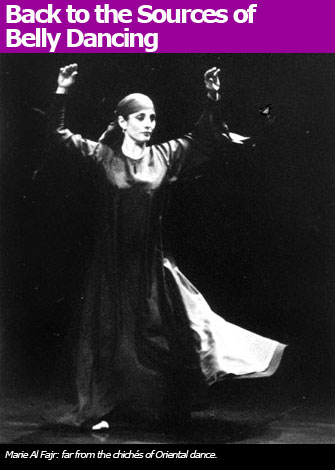

You would have had to have been living on the moon for the last decade not to have noticed the increasingly popularity of Oriental dance in the Western world. The number of shows, performers and dance classes full of shimmying ladies – and the odd gent – dressed in colorful costumes and coin belts are testament to its increasing foothold in the everyday dance world on this side of the globe.
The alluring movements and vibrant music, particularly the drumming, are of course intoxicating and are spurring many to head to the nearest class. But there are fears among purists that a clichéd version of dance from the Arab world is being represented in cabaret acts and elsewhere. The Institut du Monde Arabe is hoping to redress this with a series called Les Rendez-vous de la Danse (through May 19), intended to offer a fuller, more authentic portrayal of Oriental dance.
I was invited to see February’s production, Roda ou le Jardin des Desires, which marries traditional dance with modern choreography in a portrayal of love and desire based on classical Arabic poetry and set among the greenery of the island of Roda (“garden”) in Cairo.
Performed by two skilled dancers, Marie Al Fajr and Ainhoa Izagirre from the Compagnie Marie Al Fajr, a suite of eight “moments” – some of them solos, some danced as a duo – took us deftly through the states of two people in love, from its germination to an ecstatic end.
Musicians Nicolas Derolin and Wassim Halal provided hypnotic, exhilarating rhythms on their frame drums for some of the dance pieces, while recorded music by lute player Georges Kazazian accompanied others. The stage was bare save for a cluster of cactus-like plants.
Instead of the expected beaded bras and coin belts, the dancers’ costumes were flowing, full-length and traditional, but the precision and mastery of movement was still clearly visible underneath. While I was initially disappointed that I wasn’t receiving the sensory overdose I usually enjoy from Oriental dance shows, it was clear that I was being treated to a much deeper cultural experience in which subtlety reigned.
Another difference was that dexterity of movement was used as a tool of expression rather than an end in itself, opening the doors to Arabic and Egyptian culture far wider than would ever be possible in a cabaret show.
Upcoming shows in the series look to be similarly enlightening. A tribute to Mohamed Abdel Wahab, a 20th century singer and composer who is considered one of the greats of Arabic music, will be held in March, with both choreographed and improvised performances, solos and duos with Eastern and Western influences, set to pieces from Wahab’s repertoire performed by six live musicians.
In May, Nacera Belaza will perform Le Cri, billed as an intimate, intense piece mixing traditional music with modern choreography. It aims to capture a state of mind fueled by the relationship between inner emptiness and the outside world.
This series offers a lesson to many of us who are interested in Oriental dance and the culture behind it: we have really only scratched the surface.
Institut du Monde Arabe: 1, rue des Fossés-Saint-Bernard, 75005 Paris. Métro: Jussieu. Tel.: 01 40 51 38 38. Tickets: up to €24. Through May 19. www.imarabe.org
© 2009 Paris Update
Reader Reaction
Click here to respond to this article (your response may be published on this page and is subject to editing).
